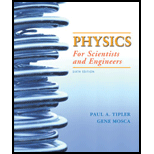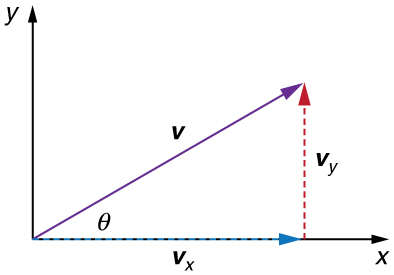
Concept explainers
(a)
To Calculate: The magnitude and the direction of
(a)
Answer to Problem 49P
Magnitude of the resultant velocity vector
Direction of the resultant velocity vector
Explanation of Solution
Given data
Velocity at
The angle of velocity at
Velocity at
The angle of velocity at
Displacement of x at
Displacement of y at
Formula used

where a is the acceleration and v and t represent velocity and time respectively.
Calculation
At
Velocity component in horizontal direction =
Velocity component in vertical direction =
At
Velocity component in horizontal direction =
Velocity component in vertical direction =
Total velocity components in horizontal direction =
Total velocity components in vertical direction =
Resultant velocity after
Conclusion
The magnitude of the resultant velocity vector
The direction of the resultant velocity vector
(b)
To Calculate: The magnitude and the direction of
(b)
Answer to Problem 49P
Magnitude of the resultant acceleration vector
Direction of the resultant acceleration vector
Explanation of Solution
Given data
Velocity at
The angle of velocity at
Velocity at
The angle of velocity at
Displacement of x at
Displacement of y at
Formula used
Calculation
The magnitude of the resultant acceleration vector
The direction of the resultant acceleration vector
Conclusion
Magnitude of the resultant acceleration vector
Direction of the resultant acceleration vector
Want to see more full solutions like this?
Chapter 3 Solutions
Physics For Scientists And Engineers
- At time t = 13 s, the velocity of a particle moving in the x-y plane is v = 0.09i + 2.90j m/s. By time t = 13.07 s, its velocity has become -0.04i + 2.74j m/s. Determine the magnitude aav of its average acceleration during this interval and the angle θ made by the average acceleration with the positive x-axis. The angle θ is measured counterclockwise from the positive x-axis.arrow_forwardAt t = 0 the coordinates of a particle are x = 0, y = 1.98 m. At a time 0.95 s later, its coordinates are x = 3.21 m, y = 4.20 m. Find the components of the particle's average velocity during this time interval. vx = vy =arrow_forwardAt one instant, a bicyclist is 50 m due east of a park's flagpole, going due south with a speed of 18 m/s. Then, 13 s later, the cyclist is 45 m due north of the flagpole, going due east with a speed of 13 m/s. For the cyclist in this 13 s interval, what is the displacement (m) and direction north of west, average velocity (m/s) and direction north of west and the average acceleration and direction north of east?arrow_forward
- An atom is constrained to move along the horizontal axis only. At time t = 0.5 s, the atom is at x = 0.06 m. At time t = 2.8 s, the atom is at x = 0.46 m. What is the atom's average velocity?arrow_forwardA particle leaves the origin with initial velocity v⃗ o=12i^+12j^m/s , undergoing constant acceleration a⃗ =−1.0i^+0.28j^m/s2 . When does the particle cross the y�-axis?arrow_forwardat t=0, a particle leaves the origin with a velocity of 12m/s in the positive x-direction and moves in the xy plane with a constant acceleration of (-2.0i + 4.0j)m/s2. at the instant the y coordinate is 18m, what is the x coordinate of the particle?arrow_forward
- A rock is At t = 0, a particle leaves the origin with a velocity of 12 m/s in the positive x direction and moves in the xy plane with a constant acceleration of (–2i + 4j) m/s2. At the instant the y coordinate of the particle is 18 m, what is the x coordinate of the particle?arrow_forwardA football is placed at rest on the field with initial coordinates x0 = 0 and y0 = 0. The ball is then kicked and thereby given an initial velocity of magnitude v0 = 23.6 m/s and direction θ0 = 36.3o above the horizontal. Ignore the effects of air resistance. Initial horizontal component of the velocity v0x = Initial vertical component of the velocity v0y = Horizontal component of the acceleration ax = Vertical component of the acceleration ay = Enter the equation for the horizontal position versus time, x(t) = Enter the equation for the vertical position versus time, y(t) = Enter the equation for the horizontal velocity versus time, vx(t) = Enter the equation for the vertical velocity versus time, vy(t) = Enter the equation for the total velocity versus time, v(t) = Enter the equation for the angle of the velocity vector versus time, θ(t)= Enter the maximum height of the football Enter the range of the football Enter the time it takes for the football to reach its maximum…arrow_forwardAt t = 0, a particle leaves the origin with a velocity of 9.0 m/s in the positive ydirection and moves in the xy plane with a constant acceleration of (2.0i - 4.0j)m/s2. At the instant the x coordinate of the particle is 15 m, what is the speedof the particle?arrow_forward
- 22)))At t = 0, a particle moving with constant acceleration in the xy plane has a velocity v = (3.00i-2.00j) m / s at its origin. At t = 3.00 s, the velocity of the particle is v = (9.00i + 7.00j) m / s. Find the acceleration of the particle?arrow_forwardA particle leaves the origin with initial velocity v0= 12i + 14j m/s, undergoing constant acceleration a = -0.80i + 0.25j m/s2. If the particle crosses the y-axis at t = 30s and its y-coordinate at the time is 532.5m. How fast is it moving and in what direction is it moving?arrow_forwardIf the vector components of the position of a particle moving in the xy plane as a function of time are x = (2.8 m/s2)t2 and y = (6.4 m/s3)t3, at what time t is the angle between the particle's velocity and the x axis equal to 45°?arrow_forward
 Principles of Physics: A Calculus-Based TextPhysicsISBN:9781133104261Author:Raymond A. Serway, John W. JewettPublisher:Cengage Learning
Principles of Physics: A Calculus-Based TextPhysicsISBN:9781133104261Author:Raymond A. Serway, John W. JewettPublisher:Cengage Learning
